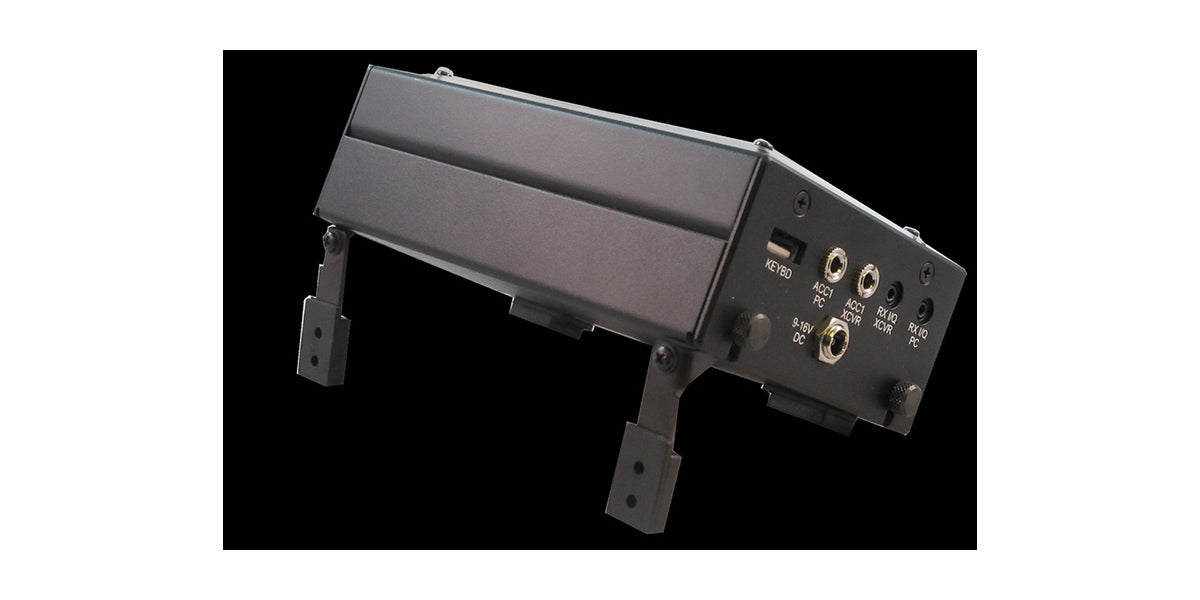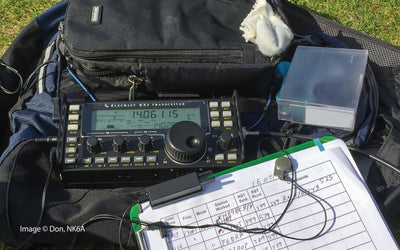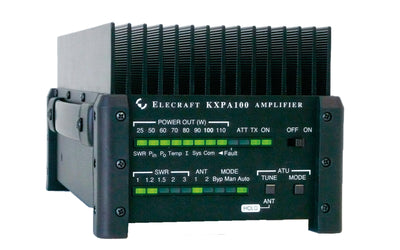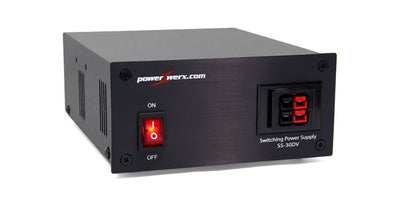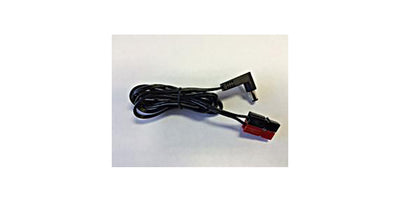PX3 PANADAPTER KIT
Portable, High-Performance Panadapter for the KX3 Transceiver allows you to 'see' the current band, in real time, with spans of 2-200 kHz. The PX3 has many powerful signal processing features, as well as multi-line CW/data text send/receive that works great with an attached USB keyboard.
Note: KX3 and Paddle in picture are not included.
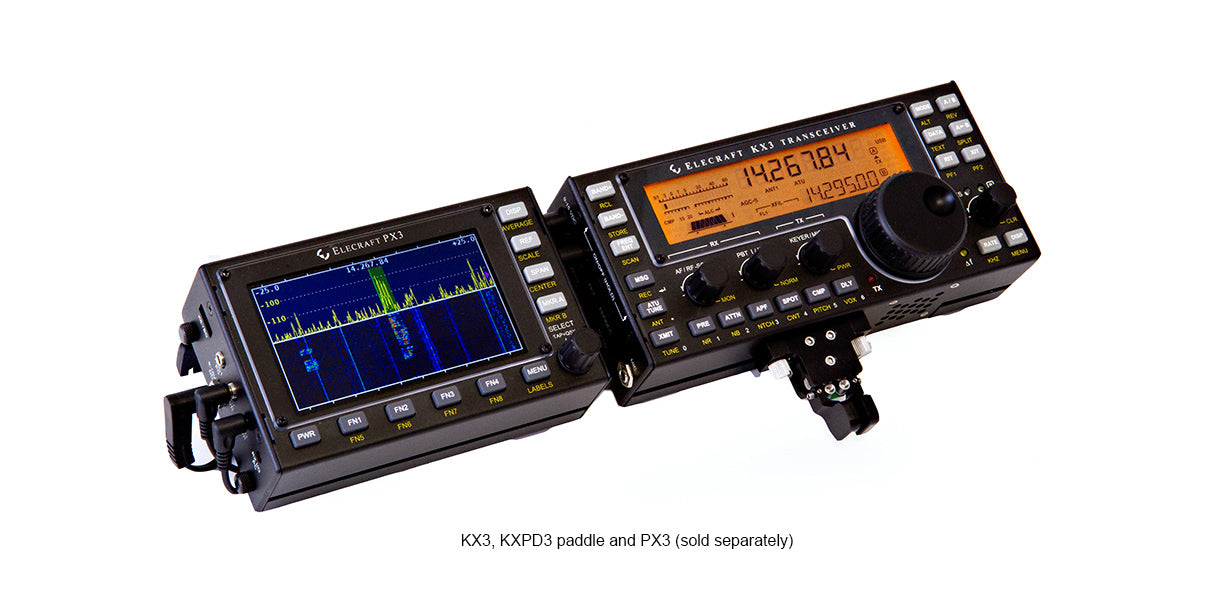

- Overview
- PX3 Packages
- Specs
- Reviews
- FAQ
- Manuals & Downloads
- Price List/Order
OVERVIEW
The PX3 Panadapter adds a visual dimension to signal hunting, with fast, real-time spectrum and waterfall displays of band activity. Its small size and weight make it ideal for travel or field use.
The PX3 is fully integrated with the Elecraft KX3, utilizing its serial control port and RX I/Q signals*. The panadapter tracks the KX3’s VFO frequency and filter settings via on-screen cursors. You can point and click on signals by rotating and tapping the PX3’s SELECT knob.
With its very wide dynamic range and frequency span of up to 200 kHz, the PX3 offers better performance than most PC sound cards. It’s also one of the most sensitive panadapters available, detecting signals down to the noise floor of the KX3. A PC or Mac can still be connected to the KX3 (via the PX3) for use with logging and control programs.
Advanced Features and Signal Processing
PX3 features include CW/RTTY/PSK text display, multi-pass signal averaging to pull out weak signals, peak detection to show total activity on the band, adjustable reference level, and amplitude range scaling. There’s also a full set of programmable switches to access often-used settings.
The PX3 has a wide supply voltage range (8-15 V) and low current drain (typ. 140 mA @ 13.8 V). It includes a comprehensive manual, and is available factory assembled or as a modular, no-soldering kit.
PX3 Packages
Packages come factory assembled or as a kit.
KX3 SHACK options cannot be substituted for other options or accessories.
SPECS
- Weighs just 13 oz (0.37 kg); enclosure size: 5.4 x 3.4 x 1.7” (13.7 x 8.6 x 4.3 cm
- CW/RTTY/PSK text display
- Tracking and Fixed Tune display modes
- DSP Noise Blanker for display
FAQ
Q: What is a panadapter used for?
A: A panadapter, also known as a spectrum scope, is a device with a 2-dimensional display showing frequency on its X-axis and signal amplitude on its Y-axis. This allows you to see signals on a given band, over a much wider range than you can normally only hear them. The most basic use of a panadapter is to simply locate signals; sometimes a band will seem dead on your receiver, while the panadapter will show one or more stations. In this case you can use the PX3s marker (QSY) knob to point at a signal of interest, then push (tap) on the knob to move the KX3 to that frequency. This is a great way to find DX stations, and you can often tell what the stations operating mode is once you become familiar with their various patterns. Another common use is to observe the nature of a split-pileup, using the PX3 to see who a DX station is working, then set your own transmitter to about the same frequency. (For additional information and illustrated examples, please refer to the PX3 owners manual, which can be downloaded from our PX3 web page.)
Q: What is a waterfall display?
A: The PX3 can show a waterfalldisplay, which shows a running history of band activity. Signals pourdown the waterfall, in time, with their color showing how strong they are. Each type of signal creates a unique signature (with a little practice you can even copy Morse code right on the waterfall display, in the form of colored dots and dashes). When the reference level (REF) is adjusted so that the bands noise floor is right at the bottom of the spectral display, the waterfall will be mostly dark, with signals appearing as light areas. This tells you at a glance where signals have recently been, even if theyre not transmitting at the moment.
Q: Why is the PX3 always placed to the left of the KX3 in example photos?
A: This minimizes physical cable length between the two units, keeps them spaced close together, and keeps the PX3 away from the KX3s antenna jack, which may be important if an end-fed wire antenna is being used. The PX3s supplied cables have compact, right-angle plugs, and can be routed underneath the PX3 to maintain a clean station appearance.
Q: How does the PX3 (used with the KX3) compare to the P3 (used with the K3)?
A: The PX3 has nearly all of the same features as the P3*, including the same high-resolution color display, 2 to 200 kHz SPAN, fast sweep rates, and 8 programmable hot keysto do quick setup. The primary difference between the two is in the interface to the transceiver. The P3 digitally down-converts the K3s 8.215-MHz I.F. signal, while the PX3 uses quadrature baseband demodulation (I/Q) to convert signals from the KX3s RX I/Q output jack. The PX3s method requires less interface and demodulation circuitry, resulting in a significantly lower-cost unit with lower power consumption (consistent with portable use). For details on how baseband I/Q demodulation impacts performance, see the next item.
* Fixed tune" mode is not yet available in the PX3. If this feature is added at a future date, it may have somewhat different performance than in the P3, in terms of displayed bandwidth and allowed offset from the currently-tuned frequency.
Q: How does PX3 performance compare to PC-based panadapter applications?
A: The PX3 can display spans of up to 200 kHz, whereas most PC-based panadapters using I/Q demodulation are limited to about 40 kHz spans. The PX3 is also very tightly integrated with the KX3, making it very convenient to use.
Like PC-based panadapter applications, the PX3 makes use of baseband RX I/Q signals from the KX3. These signals are sampled by an analog-to-digital converter (ADC), then mathematically processed to create the spectral and waterfall displays. Because the process is analog, it is subject to possible noise pickup from various sources, including switching power supplies, 60-Hz AC, ground loops, and interface cables. In the case of a PC panadapter application, a sound card must be used, and performance will only be as good as the ADC used on the sound card. The PX3s ADC is very high performance, resulting in a low noise floor, and the supplied cables are very short to minimize noise pickup. However, the PX3 is still subject to pickup from some noise sources, and the operator may see a few discrete spurs from station power supplies, etc., especially when wider spans are used (over 70 kHz or so).I/Q demodulation may also show a greater number of artifacts, such as opposite-sideband images, than I.F.-derived digital down-conversion (which is used in the P3). However, when the PX3 is properly aligned, such artifacts will be significantly suppressed (typically by 60 dB or better).
Q: Does the PX3 have noise blanking?
A: Yes. When pulse-type noise is present that might cause the display to jumpup and down or become otherwise impacted, the user can turn on the NB function (in the menu) and adjust its level (another menu entry). The NB should only be used when really necessary since, as with all NB functions, the blanking algorithm may interact with strong on-air signals to create unwanted artifacts.
Q: Is any test equipment needed to build the PX3 kit?
A: No. The only builder alignment step is to null the opposite-sideband image at one frequency on each band, and this is accomplished using the PX3s built-in RF signal source.
Q: If large signals cause visual artifacts in the spectral display, what steps can I take?
A:(1) Try using a narrower SPAN setting. (2) Try turning off the KX3's preamp, or setting the preamp gain lower (using the PREAMP menu entry, which is per-band). (3) The KX3's attenuator can also be used when needed. (4) If you see artifacts close to the center of the PX3's screen, try shifting them to the side by setting the KX3's RX SHFT menu entry to 8.0 rather than NOR. This is especially effective for small SPAN settings. (5) If you have a shortwave broadcast station in close proximity that is causing problems, you might consider inserting a notch filter to attenuate it. But usually the previous steps will suffice.
Q: If small signals are obscured by noise or other artifacts, what steps can I take?
A:(1) Try using a narrower SPAN. Baseband spectrum demodulation is subject to more artifacts and noise at wider spans. (2) Try turning on the KX3's preamp. (3) If you see noise at the very center of the spectrum plot on quiet bands, try setting the KX3's RX SHFT menu entry to 8.0 rather than NOR.
Installing Firmware
Q: What is the best way to update the firmware in the PX3?
A: Where possible please connect the KXUSB cable directly to the PX3. This ensures that the file transfers are not interrupted in any way while the new firmware loads.
Q: What if it isn't easy for me to remove the PX3 from the KX3 and KXPA100 cabling, how can I still update firmware for the KX3, PX3 and KXPA100?
Answer: Here is how you can easily update any one of the 3 products.
| I want to update my | KX3 | PX3 | KXPA100 |
|---|---|---|---|
| What to turn on/off | Turn Off | Turn Off | Leave On |
| What to turn on/off | Turn Off | Leave On | Turn Off |
| What to turn on/off | Leave On | Turn Off | Turn Off |
Ordering and Configuration
Q: What comes in the box with the PX3?

Q: I already have a KX3/KXPA100 combination. What do I need to order with my PX3 to obtain a fully integrated combination?
A: With either setup:
- Select either the PX3-K, kit version or the PX3-F, factory-built version.
- Connecting cables to the KX3 are shipped with the PX3 and will be in the box with it when it arrives to you. There is nothing else needed for connecting it to your KX3.
- Order the PWR12V1A-US for use in your shack or anywhere you have 120V AC for power.
*** NOTE: The PWR12V1A-US can power the only the PX3. It is not intended to power the KX3. ***
Q: I am planning on installing my PX3/KX3 combination in a Go-Box. What are the dimensions of the PX3?
A: 
Connecting the PX3 to the KX3/KXPA100
Q: What are the supported methods for connecting the PX3 to my KX3 and KX3/KXPA100 combo?
A: All Elecraft PX3 cabling is designed to support the following wiring methods.
For the PX3 and KX3, here are the interconnections.

When used with the KX3 and KXPA100 combo, the wiring will be arranged in this way.

Powering the PX3
Q: I see there is a separate power connector for the PX3. How to I power the KX3 and KX3 for portable use?
A: The PX3 is shipped with its own power cable as does the KX3. While the KX3 cannot power the PX3 from its own batteries, both the KX3 and PX3 can be powered from an external source. Connect the 2 power cables together for this purpose. In this way, you can monitor battery voltage directly from the KX3.
Q: I am planning to take my PX3 and KX3 portable, what are the PX3 power requirements?
A: The PX3 has a wide supply voltage range (8-15 V) and low current drain (typ. 140 mA @ 13.8 V).
Q: I see there is an AC power supply available for ordering on the PX3 web site. What is the PWR12V1A power source's intended use?
A: This is intended to directly power the PX3 when 120v is available. It will ship with an adapter cable for the right angle connection to the PX3.

Q: Will the PWR12V1A also power the KX3?
A: No. This power supply is intended only for the PX3. It does not supply sufficient current to run a KX3 at rated output.
Operating the PX3 with other radios
Q: How can I use the PX3 with other radios?
A: Yes, you can if your radio has I/Q signals available, you can connect the PX3 to it to see RF spectrum with it. Due to the highly integrated nature of the KX3/PX3 combination, there will be some features of the PX3 not available when connected in this way. You will, however, be able to see RF spectrum activity with the PX3.
Q: Does the PX3 work with the K3?
A: No. The PX3 requires I/Q signals for input which is supplied by the KX3. The PX3's companion product, the P3, uses Intermediate Frequencies for input, which is supplied by the K3. Both units are optimized for operation with their respective radios. The result is full integration for both. They cannot, however, be interchanged for this reason.
Q: Can I use the P3 with a KX3?
A: No, the KX3 is a direct-conversion receiver which means that it does not have an Intermediate Frequency. Since the P3 requires an Intermediate Frequency for operation, it will not work with the KX3.
Using the PX3 with logging and CAT control programs
Q: My logging program requires that it be able to connect to the KX3. How does this work when the PX3 is connected to the KX3's ACC1 port?
A: The PX3 has been engineered to be 'transparent' to any computer program that needs to gain access to the KX3's frequency and mode information. That is, your logging program will be able to access the KX3 even though you have a PX3 connected with it. You will be connecting your computer's cable to the PX3's ACC1 port, which provides this 'pass-through' feature. See the wiring diagrams in this FAQ for supported connections.


